Peugeot Partner Tepee 2015 Owner's Manual
Manufacturer: PEUGEOT, Model Year: 2015, Model line: Partner Tepee, Model: Peugeot Partner Tepee 2015Pages: 276, PDF Size: 12.76 MB
Page 121 of 276
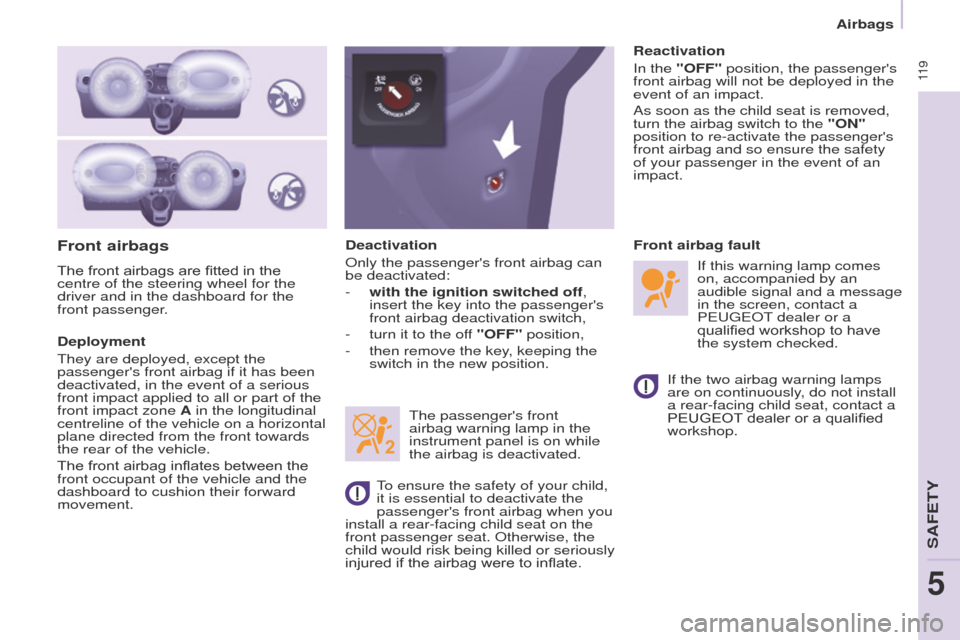
11 9
Partner_2_VP_en_Chap05_Securite_ed02-2014
Front airbags
The front airbags are fitted in the
centre of the steering wheel for the
driver and in the dashboard for the
front passenger.
Deployment
t
hey are deployed, except the
passenger's front airbag if it has been
deactivated, in the event of a serious
front impact applied to all or part of the
front impact zone A in the longitudinal
centreline of the vehicle on a horizontal
plane directed from the front towards
the rear of the vehicle.
The front airbag inflates between the
front occupant of the vehicle and the
dashboard to cushion their forward
movement. Deactivation
Only the passenger's front airbag can
be deactivated:
-
with the ignition switched off
,
insert the key into the passenger's
front airbag deactivation switch,
-
turn it to the of
f "OFF" position,
-
then remove the key
, keeping the
switch in the new position.
t
he passenger's front
airbag warning lamp in the
instrument panel is on while
the airbag is deactivated. If the two airbag warning lamps
are on continuously, do not install
a rear-facing child seat, contact a
PEUGEOT dealer or a qualified
workshop.
Front airbag fault
to ensure the safety of your child,
it is essential to deactivate the
passenger's front airbag when you
install a rear-facing child seat on the
front passenger seat. Otherwise, the
child would risk being kille
d or seriously
injured if the airbag were to inflate. Reactivation
In the "OFF" position, the passenger's
front airbag will not be deployed in the
event of an impact.
As soon as the child seat is removed,
turn the airbag switch to the "ON"
position to re-activate the passenger's
front airbag and so ensure the safety
of your passenger in the event of an
impact.
If this warning lamp comes
on, accompanied by an
audible signal and a message
in the screen, contact a
P euge O t
dealer or a
qualified workshop to have
the system checked.
Airbags
SAFetY
5
Page 122 of 276
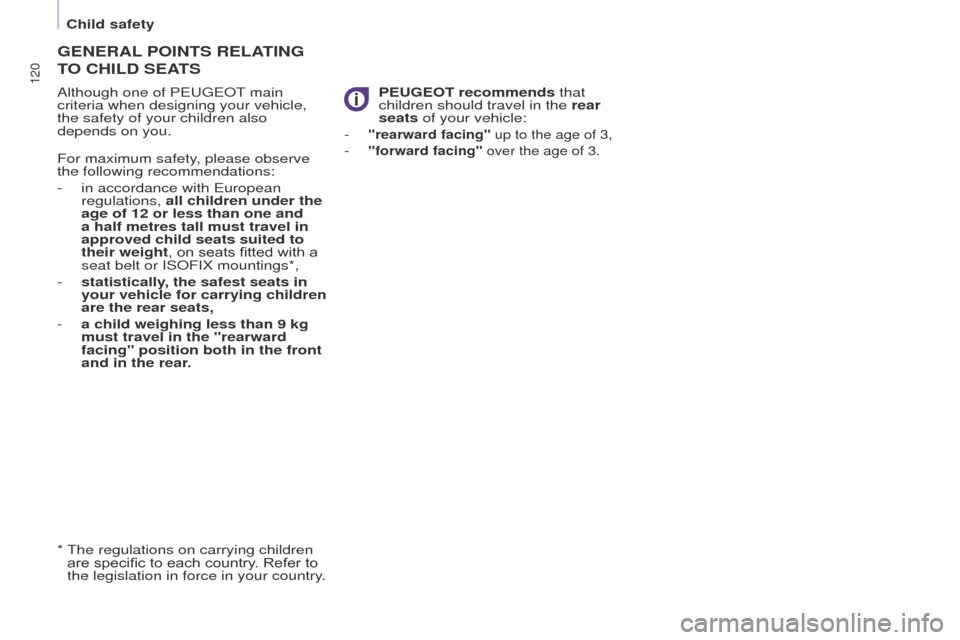
120
Partner_2_VP_en_Chap05_Securite_ed02-2014
GENERAL POINTS RELATING
T
O CHILD SEATS
Although one of PeugeOt main
criteria when designing your vehicle,
the safety of your children also
depends on you. PEUGEOT recommends
that
children should travel in the rear
seats of your vehicle:
*
t he regulations on carrying children
are specific to each country. Refer to
the legislation in force in your country.
For maximum safety, please observe
the following recommendations:
-
in accordance with
e uropean
regulations, all children under the
age of 12 or less than one and
a half metres tall must travel in
approved child seats suited to
their weight, on seats fitted with a
seat belt or ISOFIX mountings*,
-
statistically
, the safest seats in
your vehicle for carrying children
are the rear seats,
-
a child weighing less than 9 kg
must travel in the "rearward
facing" position both in the front
and in the rear
. -
"rearward facing" up to the age of 3,
- "forward facing" over the age of 3.
Child safety
Page 123 of 276
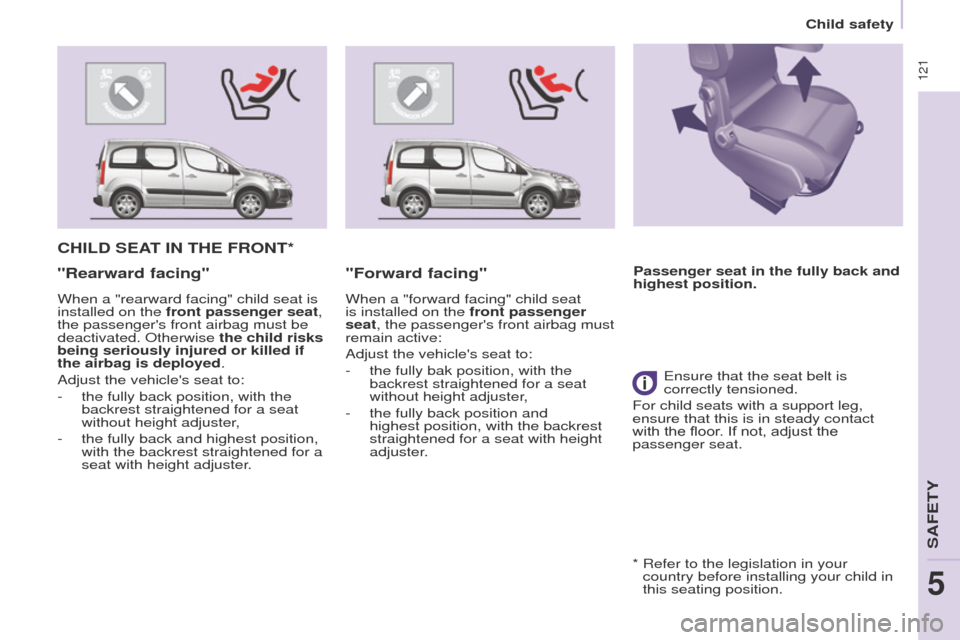
121
Partner_2_VP_en_Chap05_Securite_ed02-2014
CHILD SEAT IN THE FRONT*
"Rearward facing"
When a "rearward facing" child seat is
installed on the front passenger seat,
the passenger's front airbag must be
deactivated. Otherwise the child risks
being seriously injured or killed if
the airbag is deployed.
Adjust the vehicle's seat to:
-
the fully back position, with the
backrest straightened for a seat
without height adjuster
,
-
the fully back and highest position,
with the backrest straightened for a
seat with height adjuster
.
"Forward facing"
When a "forward facing" child seat
is installed on the front passenger
seat, the passenger's front airbag must
remain active:
Adjust the vehicle's seat to:
-
the fully bak position, with the
backrest straightened for a seat
without height adjuster
,
-
the fully back position and
highest position, with the backrest
straightened for a seat with height
adjuster
.
e
nsure that the seat belt is
correctly tensioned.
For child seats with a support leg,
ensure that this is in steady contact
with the floor. If not, adjust the
passenger seat.
*
Refer to the legislation in your
country before installin
g your child in
this seating position.
Passenger seat in the fully back and
highest position.
Child safety
SAFetY
5
Page 124 of 276

122
Partner_2_VP_en_Chap05_Securite_ed02-2014
CHILD SEAT AT THE REAR
"Rearward facing"
When a "rearward facing" child seat is
installed on a rear passenger seat,
move the vehicle's front seat forwards
and straighten the backrest so that the
"rearward facing" child seat does not
touch the vehicle's front seat.
"Forward facing"
When a "forward facing" child seat is
installed on a rear passenger seat,
move the vehicle's front seat forwards
and straighten the backrest so that the
legs of the child in the "forward facing"
child seat do not touch the vehicle's
front seat.
e
nsure that the seat belt is
correctly tensioned.
For child seats with a support leg,
ensure that this is in firm contact with
the floor. When a child seat is installed on a
passenger seat in row 3, put the
backrests of the outer and centre seats
in row 2 in front of the seat occupied by
the child seat in the table position, or if
this is not sufficient, rermove the seats
in row 2 so that the child seat or the
the legs of the child do not touch the
seats in row 2. Seats in row 3
A child seat with a support leg
must never be installed on a
passenger seat in row 3.
Child safety
Page 125 of 276
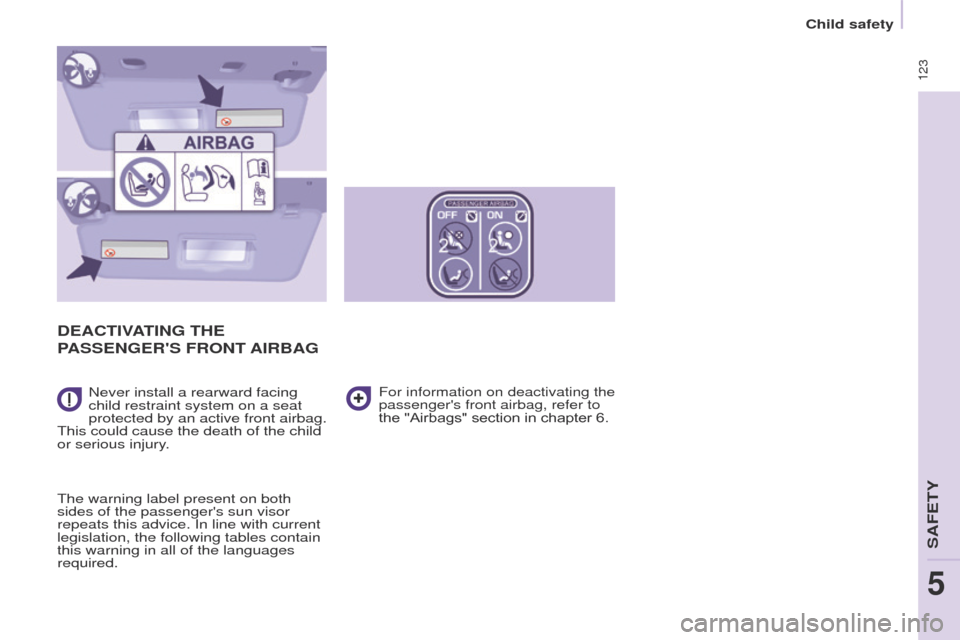
123
Partner_2_VP_en_Chap05_Securite_ed02-2014
DEACTIVATING THE
P
ASSENGER ' S
FRONT
AIRBAG
Never install a rearward facing
child restraint system on a seat
protected by an active front airbag.
t
his could cause the death of the child
or serious injury.
t
he warning label present on both
sides of the passenger's sun visor
repeats this advice. In line with current
legislation, the following tables contain
this warning in all of the languages
required.For information on deactivating the
passenger's front airbag, refer to
the "Airbags" section in chapter 6.
Child safety
SAFetY
5
Page 126 of 276
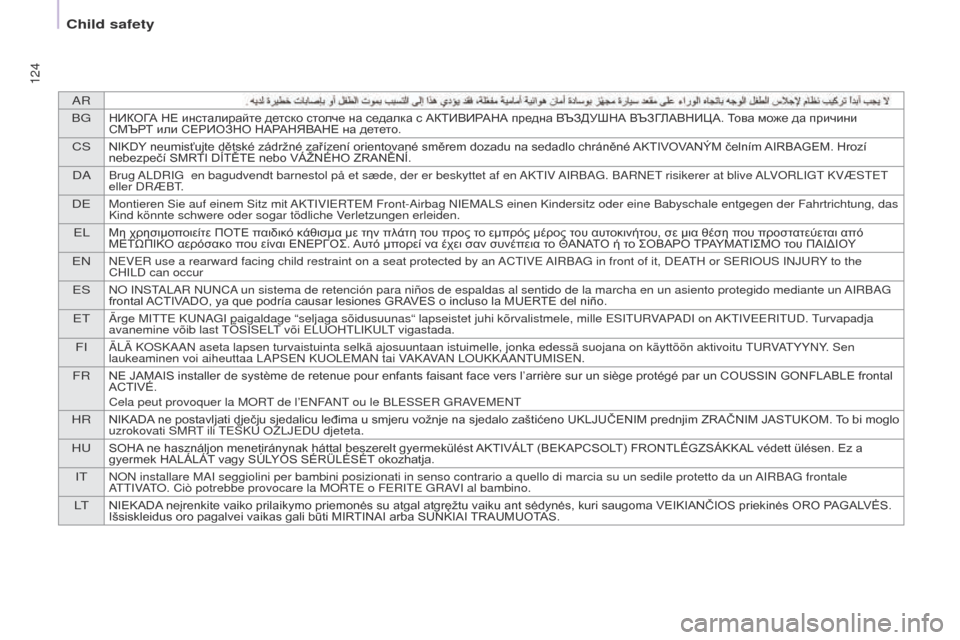
AR
B g
НИКОГА НЕ инсталирайте детско столче на седалка с АКТИВИРАНА предна ВЪЗДУШНА ВЪЗГЛАВНИЦА. Това може да причини
СМЪРТ или СЕРИОЗНО НАРАНЯВАНЕ на детето.
CSNIKDY neumisťujte dětské zádržné zařízení orientované směrem dozadu na sedadlo chráněné AKTIVOVANÝM čelním AIRBAGEM. Hrozí
nebezpečí SMRTI DÍTĚTE nebo VÁŽNÉHO ZRANĚNÍ.
DABrug ALDRIg en bagudvendt barnestol på et sæde, der er beskyttet af en AKtIV AIRBAg. BARNet risikerer at blive ALVORLI gt KVÆS tet
eller DRÆB t.
DeMontieren Sie auf einem Sitz mit AKtIVIeRte M Front-Airbag NI e MALS einen Kindersitz oder eine Babyschale entgegen der Fahrtrichtung, d\
as
Kind könnte schwere oder sogar tödliche Verletzungen erleiden.
eLΜη χρησιμοποιείτε ΠΟΤΕ παιδικό κάθισμα με την πλάτη του προς το εμπρός μέρος του αυτοκινήτου, σε μια θέση που προστατεύεται από
ΜΕΤΩΠΙΚΟ αερόσακο που είναι ΕΝΕΡΓΟΣ. Αυτό μπορεί να έχει σαν συνέπεια το ΘΑΝΑΤΟ ή το ΣΟΒΑΡΟ ΤΡΑΥΜΑΤΙΣΜΟ του ΠΑΙΔΙΟΥ
eNNeVeR use a rearward facing child restraint on a seat protected by an ACtIVe AIRBAg in front of it, DeAt H or S e RIO u S INJ u RY to the
CHILD can occur
eSNO INStALAR N u NCA un sistema de retención para niños de espaldas al sentido de la m\
archa en un asiento protegido mediante un AIRBA g
frontal ACTIVADO, ya que podría causar lesiones GRAVES o incluso la MUERTE del niño.
etÄrge MItte KuNAgI paigaldage “seljaga sõidusuunas“ lapseistet juhi kõrvalist\
mele, mille eSItuRVAPADI on AKtIVeeRItuD. turvapadja
avanemine võib last t ÕSIS e Lt või e L u OH t LIK u Lt vigastada.
FIÄLÄ KOSKAAN aseta lapsen turvaistuinta selkä ajosuuntaan istuim\
elle, jonka edessä suojana on käyttöön aktivoitu tu RVAt YYNY. Sen
laukeaminen voi aiheuttaa LAPS e N K u OL e MAN tai VAKAVAN LO u KKAAN tu MIS e N.
FRNE JAMAIS installer de système de retenue pour enfants faisant face vers l’arrière sur un siège protégé par un COUSSIN GONFLABLE frontal
ACTIVÉ.
Cela peut provoquer la MOR
t de l’
e NFAN t
ou le BL
e SS e R g RAV e M e N t
HRNIKADA ne postavljati dječju sjedalicu leđima u smjeru vožnje na sjedalo zaštićeno UKLJUČENIM prednjim ZRAČNIM JASTUKOM. To bi moglo
uzrokovati SMRt ili teŠK u OZLJ e D u djeteta.
HuSOHA ne használjon menetiránynak háttal beszerelt gyermekülést AKTIVÁLT (BEKAPCSOLT) FRONTLÉGZSÁKKAL védett ülésen. Ez a
gyermek HALÁLÁT vagy SÚLYOS SÉRÜLÉSÉT okozhatja.
ItNON installare MAI seggiolini per bambini posizionati in senso contrario\
a quello di marcia su un sedile protetto da un AIRBAg frontale
Att IVAtO. Ciò potrebbe provocare la MORte o F e RI te g RAVI al bambino.
LtNIEKADA neįrenkite vaiko prilaikymo priemonės su atgal atgręžtu vaiku ant sėdynės, kuri saugoma VEIKIANČIOS priekinės ORO PAGALVĖS.
Išsiskleidus oro pagalvei vaikas gali būti MIRTINAI arba SUNKIAI TRAUMUOTAS.
124
Partner_2_VP_en_Chap05_Securite_ed02-2014
Child safety
Page 127 of 276
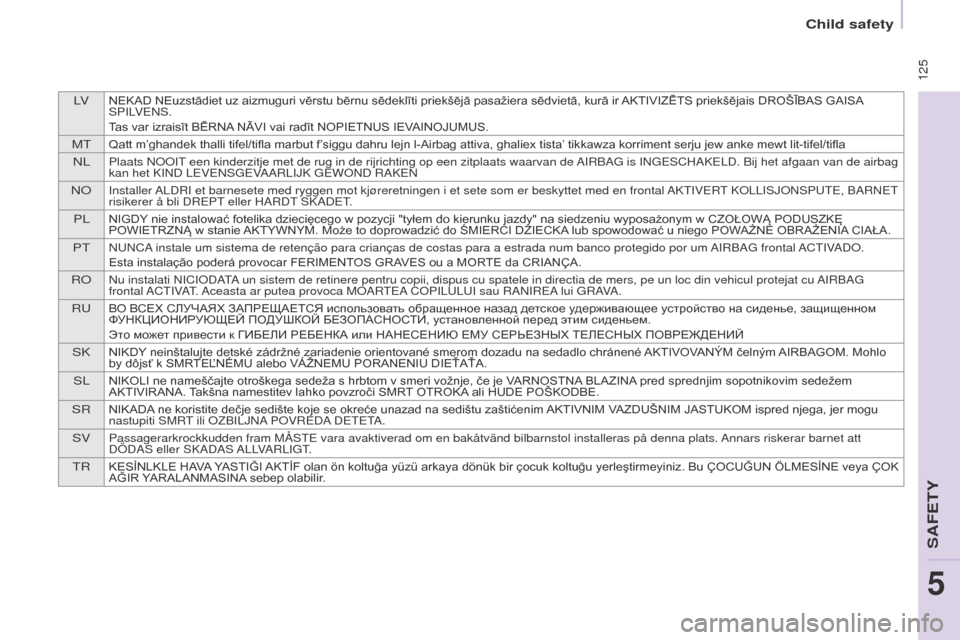
LVNEKAD NEuzstādiet uz aizmuguri vērstu bērnu sēdeklīti priekšējā pasažiera sēdvietā, kurā ir AKTIVIZĒTS priekšējais DROŠĪBAS GAISA
SPILVe NS.
Tas var izraisīt BĒRNA NĀVI vai radīt NOPIETNUS IEVAINOJUMUS.
MtQatt m’ghandek thalli tifel/tifla marbut f’siggu dahru lejn l-Airbag attiva, ghaliex tista’ tikkawza korriment serju jew anke mewt lit-tifel/tifla
NLPlaats NOOIt een kinderzitje met de rug in de rijrichting op een zitplaats waarvan d\
e AIRBA g is IN ge SCHAK e LD. Bij het afgaan van de airbag
kan het KIND L e V e NS ge VAARLIJK ge WOND RAK e N
NOInstaller ALDRI et barnesete med ryggen mot kjøreretningen i et sete som er bes\
kyttet med en frontal AKtIVeRt KOLLISJONSP ute , BARN et
risikerer å bli DR e P t eller HARD t SKAD et.
PLNIGDY nie instalować fotelika dziecięcego w pozycji "tyłem do kierunku jazdy" na siedzeniu wyposażonym w CZOŁOWĄ PODUSZKĘ
POWIETRZNĄ w stanie AKTYWNYM. Może to doprowadzić do ŚMIERCI DZIECKA lub spowodować u niego POWAŻNE OBRAŻENIA CIAŁA.
PtNuNCA instale um sistema de retenção para crianças de costas para a \
estrada num banco protegido por um AIRBAg frontal ACtIVADO.
Esta instalação poderá provocar FERIMENT OS GRAVES ou a MORTE da CRIANÇA.
RONu instalati NICIODAtA un sistem de retinere pentru copii, dispus cu spatele in directia de me\
rs, pe un loc din vehicul protejat cu AIRBA g
frontal AC t IVAt. Aceasta ar putea provoca MOARte A COPIL u L u I sau RANIR e A lui g RAVA.
RuВО ВСЕХ СЛУЧАЯХ ЗАПРЕЩАЕТСЯ использовать обращенное назад детское удерживающее устройство на сиденье, защищенном
ФУНКЦИОНИРУЮЩЕЙ ПОДУШКОЙ БЕЗОПАСНОСТИ, установленной перед этим сиденьем.
Это может привести к ГИБЕЛИ РЕБЕНКА или НАНЕСЕНИЮ ЕМУ СЕРЬЕЗНЫХ ТЕЛЕСНЫХ ПОВРЕЖДЕНИЙ
SKNIKDY neinštalujte detské zádržné zariadenie orientované smerom dozadu na sedadlo chránené AKTIVOVANÝM čelným AIRBAGOM. Mohlo
by dôjsť k SMRTEĽNÉMU alebo VÁŽNEMU PORANENIU DIEŤAŤA.
SLNIKOLI ne nameščajte otroškega sedeža s hrbtom v smeri vožnje, če je VARNOSTNA BLAZINA pred sprednjim sopotnikovim sedežem
AKTIVIRANA. Takšna namestitev lahko povzroči SMRT OTROKA ali HUDE POŠKODBE.
SRNIKADA ne koristite dečje sedište koje se okreće unazad na sedištu zaštićenim AKTIVNIM VAZDUŠNIM JASTUKOM ispred njega, jer mogu
nastupiti SMRt ili OZBILJNA POVR e DA D etetA.
SVPassagerarkrockkudden fram MÅSte vara avaktiverad om en bakåtvänd bilbarnstol installeras på de\
nna plats. Annars riskerar barnet att
DÖDAS eller SKADAS ALLVARLI gt.
tRKESİNLKLE HAVA YASTIĞI AKTİF olan ön koltuğa yüzü arkaya dönük bir çocuk koltuğu yerleştirmeyiniz. Bu ÇOCUĞUN ÖLMESİNE veya ÇOK
AĞIR YARALANMASINA sebep olabilir.
125
Partner_2_VP_en_Chap05_Securite_ed02-2014
Child safety
SAFetY
5
Page 128 of 276
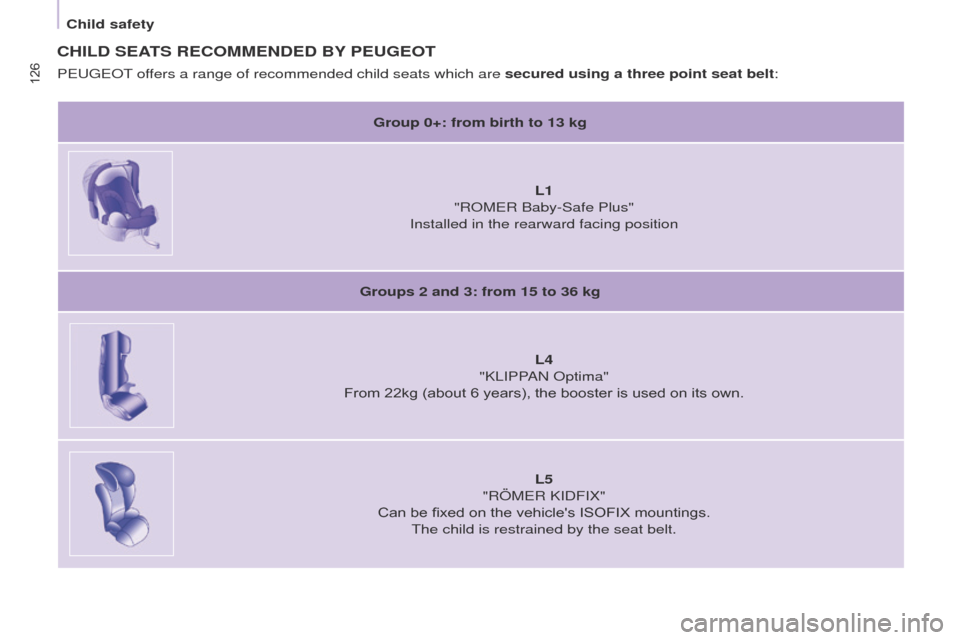
126
Partner_2_VP_en_Chap05_Securite_ed02-2014
CHILD SEATS RECOMMENDED BY PEUGEOT
Group 0+: from birth to 13 kgL1
"ROM
e R Baby-Safe Plus"
Installed in the rearward facing position
Groups 2 and 3: from 15 to 36 kg L4
"KLIPPAN Optima"
From 22kg (about 6 years), the booster is used on its own.
L5
"RÖM
e R KIDFIX"
Can be fixed on the vehicle's ISOFIX mountings.
t
he child is restrained by the seat belt.
P
euge
O
t
of
fers a range of recommended child seats which are secured using a three point seat belt:
Child safety
Page 129 of 276
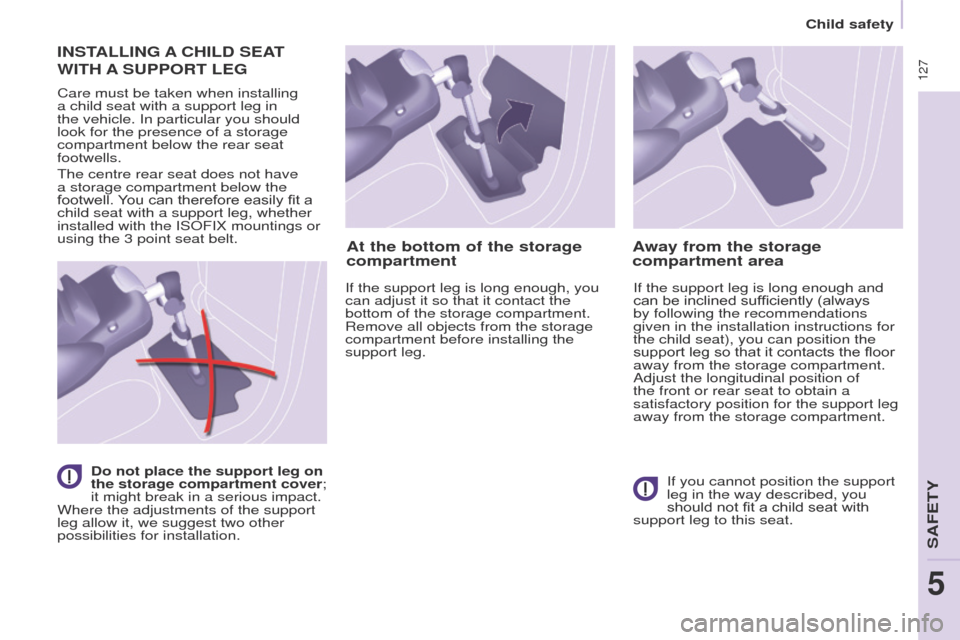
127
Partner_2_VP_en_Chap05_Securite_ed02-2014
INSTALLING A CHILD SEAT
WITH
A
SUPPORT LEG
Care must be taken when installing
a child seat with a support leg in
the vehicle. In particular you should
look for the presence of a storage
compartment below the rear seat
footwells.
t
he centre rear seat does not have
a storage compartment below the
footwell. You can therefore easily fit a
child seat with a support leg, whether
installed with the ISOFIX mountings or
using the 3 point seat belt.
Do not place the support leg on
the storage compartment cover;
it might break in a serious impact.
Where the adjustments of the support
leg allow it, we suggest two other
possibilities for installation.
At the bottom of the storage
compartment
If the support leg is long enough, you
can adjust it so that it contact the
bottom of the storage compartment.
Remove all objects from the storage
compartment before installing the
support leg.
Away from the storage
compartment area
If the support leg is long enough and
can be inclined sufficiently (always
by following the recommendations
given in the installation instructions for
the child seat), you can position the
support leg so that it contacts the floor
away from the storage compartment.
Adjust the longitudinal position of
the front or rear seat to obtain a
satisfactory position for the support leg
away from the storage compartment.
If you cannot position the support
leg in the way described, you
should not fit a child seat with
support leg to this seat.
Child safety
SAFetY
5
Page 130 of 276
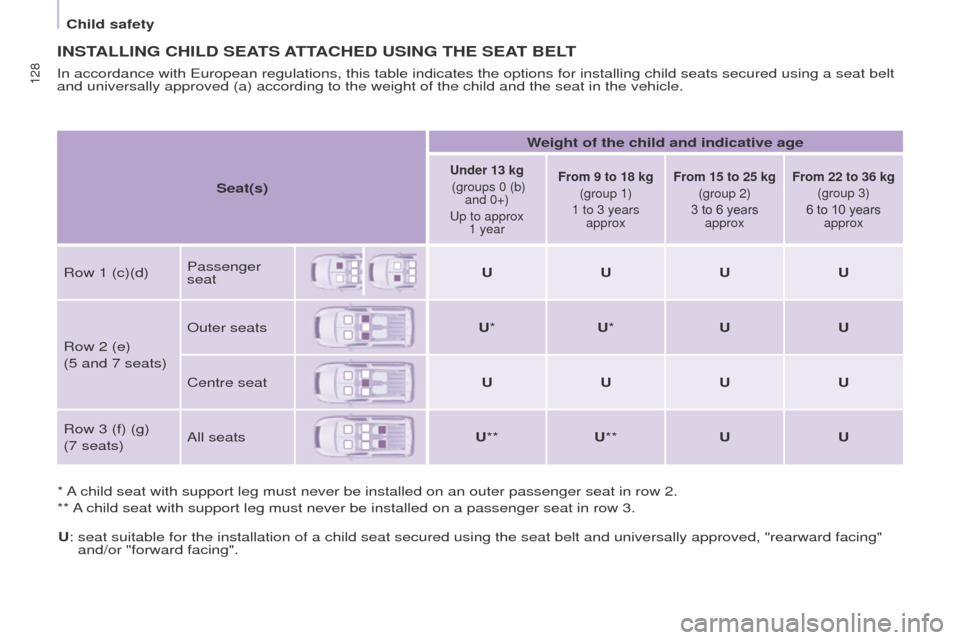
128
Partner_2_VP_en_Chap05_Securite_ed02-2014
INSTALLING CHILD SEATS ATTACHED USING THE SEAT BELT
* A child seat with support leg must never be installed on an outer passeng\
er seat in row 2.
** A child seat with support leg must never be installed on a passenger seat\
in row 3.
In accordance with
e uropean regulations, this table indicates the options for installing child seats secured using a seat belt
and universally approved (a) according to the weight of the child and \
the seat in the vehicle.
U:
seat suitable for the installation of a child seat secured using the sea\
t belt and universally approved, "rearward facing"
and/or "forward facing". Seat(s)
W
eight of the child and indicative age
Under 13 kg
(groups 0 (b) and 0+)
u
p to approx 1 year From 9 to 18 kg
(group 1)
1 to 3 years approx From 15 to 25 kg
(group 2)
3 to 6 years approx From 22 to 36 kg
(group 3)
6 to 10 years approx
Row 1 (c)(d) Passenger
seat U
UUU
Row 2 (e)
(5 and 7 seats) Outer seats
U*U* UU
Centre seat UUUU
Row 3 (f) (g)
(7 seats) All seats
U**U** UU
Child safety